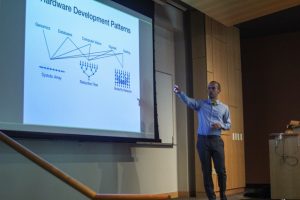 Hardware design is not easy. It typically involves writing code in low-level languages like Verilog where you must specify how every operation works at every cycle. Modern processors perform billions of operations per second making this is a very difficult task! Yet, hardware design has become increasingly important and more pervasive with the advent of custom accelerators which are used in phones, cars, and in the cloud. We need more hardware designers, but unfortunately, hardware design is hard.
Hardware design is not easy. It typically involves writing code in low-level languages like Verilog where you must specify how every operation works at every cycle. Modern processors perform billions of operations per second making this is a very difficult task! Yet, hardware design has become increasingly important and more pervasive with the advent of custom accelerators which are used in phones, cars, and in the cloud. We need more hardware designers, but unfortunately, hardware design is hard.
Dr. Dustin Richmond recently defended his PhD thesis that tackled this problem — increasing the accessibility of hardware development to non-hardware engineers through the use of common parallel patterns. As part of this, Dustin developed RIFFA (abstracting communication patterns) [1] and created a framework for synthesizing higher-order functions to hardware (abstracting computational patterns) [2].
As with most PhD students in our research group, Dustin had many side projects to distract him during his PhD career. Dustin played a key role in developing our 3D imaging system for creating 3D scans of Maya archaeological sites. This involved expeditions to Guatemala to scan ancient Maya structures, a run-in with a large black snake, and a publication in “Advances in Archaeological Practice” [3]. Dustin also built the hardware for a high framerate 3D imager in one of our first projects with Cognex [4]. This ultimately helped inform Cognex on how to build this sensor which is now a product. Dustin spent two separate internships at Altera (now Intel) and Xilinx. I’m not entirely sure how he fit all of that into one PhD, but certainly, it is impressive.
While PhD defense is mostly focused on research, it should be noted that Dustin has an equally impressive record with university service and teaching. His efforts to our community have been documented in other posts (CSE award and UCSD Graduate Student Association Awards). As a TA, he took on a major revision of our hardware curriculum in the Wireless Embedded Systems Masters Program. He introduced the Xilinx Pynq platform with a series of labs, lectures, and assignments. For the final project, he organized a hackathon where each group was able to make an impressive project in less than two weeks. We will continue to use this curriculum moving forward in that and other classes.
Dustin will continue on the academic route moving back to the Pacific Northwest to be a postdoctoral scholar with Michael Taylor and Luis Ceze. Look for him on the academic job market in 1-2 years.
-Ryan